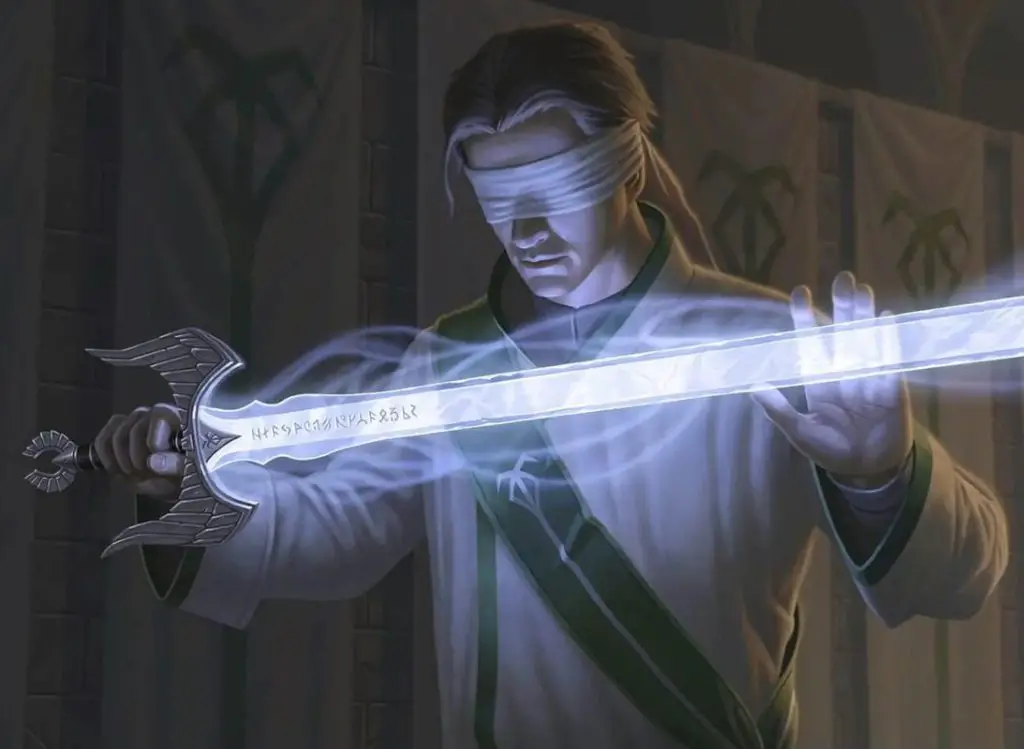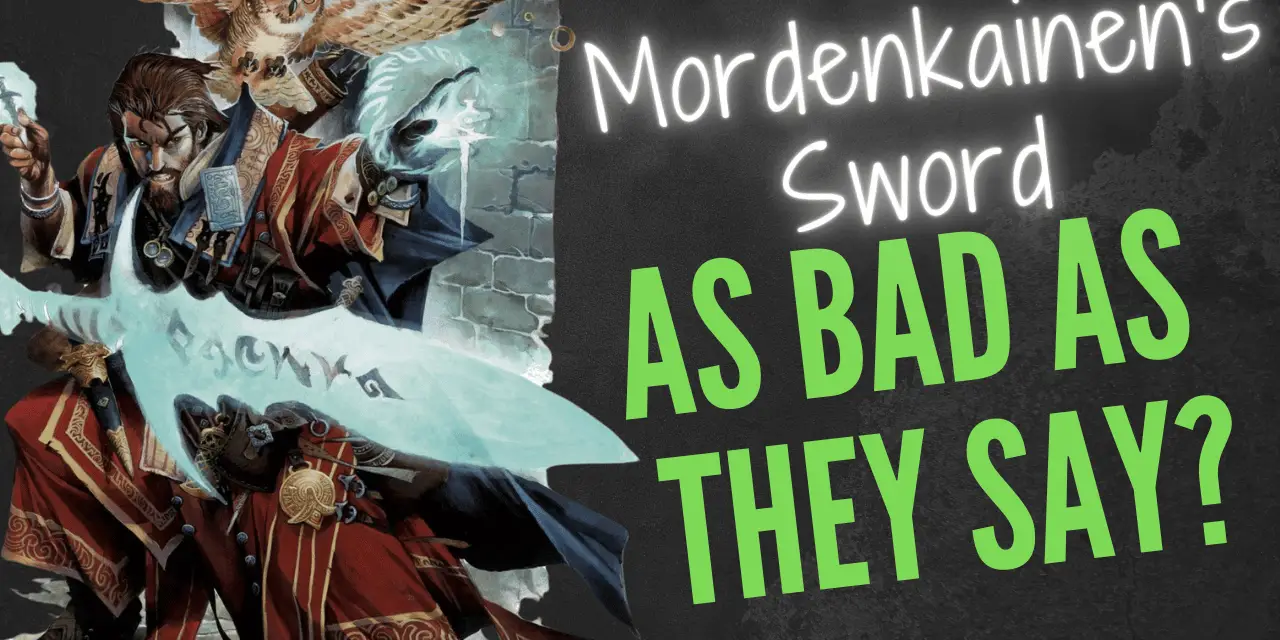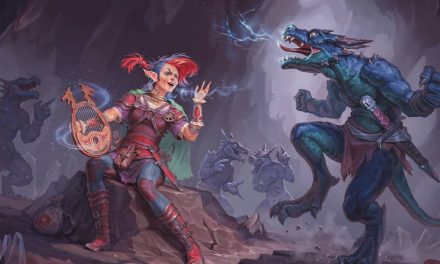Welcome, adventurers and spellcasters, to a deep dive into one of the most controversial spells in the Dungeons & Dragons 5th Edition arsenal: Mordenkainen’s Sword.
Whether you’re a seasoned Wizard seeking to expand your repertoire or a Bard eager to add some arcane flair to your performances, this spell offers a unique blend of raw power and strategic versatility.
In this article, we’ll unravel the mysteries of Mordenkainen’s Sword, exploring its mechanics, discussing how to wield it effectively in the heat of battle, and weighing its strengths and weaknesses. By the end, you’ll be ready to cut through your enemies with the precision and force of this magical blade.
So, grab your spellbook or ready that arcane focus and let’s get started on this enchanting journey through the arcane!
What Is Mordenkainen’s Sword 5e?
Mordenkainen’s Sword is a 7th-level evocation spell in D&D 5e that conjures a powerful, spectral blade of pure force.
Once summoned, this magical sword hovers within range and can be directed to attack enemies with a melee spell attack, dealing a hefty 3d10 force damage per hit. It lasts for up to 1 minute, requiring concentration, and can be moved up to 20 feet each turn as a bonus action.
Available to bards and wizards, this spell combines relatively high damage output with the versatility of force damage, making it a potentially potent addition to your spellcaster’s toolkit.
LEVEL: 7th
CASTING TIME: 1 Action
RANGE/AREA: 60 ft
COMPONENTS: V, S, M*
DURATION: 1 Minute, (Concentration)
SCHOOL: Evocation
ATTACK/SAVE: Melee
DAMAGE/EFFECT: Force
SPELL LISTS: Bard, Wizard
You create a sword-shaped plane of force that hovers within range. It lasts for the duration.
When the sword appears, you make a melee spell attack against a target of your choice within 5 feet of the sword. On a hit, the target takes 3d10 force damage. Until the spell ends, you can use a bonus action on each of your turns to move the sword up to 20 feet to a spot you can see and repeat this attack against the same target or a different one.
* – a miniature platinum sword with a grip and pommel of copper and zinc, worth 250 gp

Using Mordenkainen’s Sword 5e
So, you’ve decided to unleash the might of Mordenkainen’s Sword, eh?
This spell isn’t just about swinging a magical blade around—it’s about wielding it with finesse and strategy. Let’s dive into how you can make the most out of this arcane blade named after one of the most legendary Wizards in all of D&D!
Combat Scenarios
First things first, when should you cast Mordenkainen’s Sword?
This spell shines brightest in situations where you need to deal significant damage to a single target, especially those with a high Armor Class (AC). Its force damage is rarely resisted, making it a reliable option against a wide variety of foes.
Always remember that positioning is key.
Mordenkainen’s sword can be summoned within 60 feet, and you can move it up to 20 feet each turn as a bonus action. This mobility allows you to adapt to the flow of battle, striking where it’s most needed. Place it strategically near high-priority targets to maximize its impact over its 1-minute duration.
And don’t forget that it can attack twice when you summon it, once with the action used to summon it and then again with the bonus action on the same turn. This can be a very useful burst of force damage to ruin your first target’s day before you send your magic sword over to its next victim.
Tactics and Strategies
To truly master Mordenkainen’s Sword, consider how it can be combined with other spells and abilities.
For example, having allies use crowd control spells like Hold Person or Web can keep enemies in place, ensuring your sword has no difficulty getting in striking distance.
Remember, concentration is crucial. If you lose it, the sword vanishes. Protect yourself with spells like Mirror Image or Shield to avoid taking damage.
And don’t forget about your allies! Coordinate with your party to keep the pressure off you, allowing you to maintain focus on your magical blade.
Role in Party Dynamics
In a well-rounded adventuring party, Mordenkainen’s Sword can fill several roles.
As a Wizard or Bard, you might not be on the front lines, but this spell lets you contribute significant melee damage from a safe distance. Though even if you do prefer to get close to the action (for example, as a Bladesinger Wizard or a Valor Bard), the extra “oomph” can certainly be useful!
It complements other party members’ abilities, such as the Fighter’s tanking or the Rogue’s sneak attacks. Enemies will have to go on the defensive and potentially lose ground to avoid taking too much damage each round.
During boss fights, the sword can consistently chip away at a powerful enemy’s health, while in encounters with large groups, it can quickly dispatch key threats. Its versatility makes it a potentially valuable tool in your spellcasting arsenal, capable of adapting to various combat scenarios.
By understanding the “when” and “how” behind using Mordenkainen’s Sword, you’ll turn this spell into a formidable weapon in your magical toolkit. Whether you’re slicing through foes or strategically positioning for maximum damage, this spell will make you a force to be reckoned with on the battlefield.
Recommended: Using and Managing the Wizard’s Spellbook in D&D 5e

Pros and Cons of Mordenkainen’s Sword 5e
Every spell has its strengths and weaknesses, and Mordenkainen’s Sword is no exception. Let’s break down the pros and cons of this powerful spell so you can decide when it’s the right tool for the job.
Pros
- Force Damage: One of the biggest advantages of Mordenkainen’s Sword is that it deals force damage, which is rarely resisted. This makes it effective against a wide range of enemies, from heavily armored warriors to incorporeal or ethereal beings like specters.
- Versatile Targeting: The sword can strike any creature within 5 feet of it, and you can move it up to 20 feet each turn as a bonus action. This allows you to adapt to changing battle conditions, targeting high-priority enemies wherever they may be.
- Bonus Action Attack: Unlike many spells that require your action to maintain, Mordenkainen’s Sword uses your bonus action to attack. This frees up your action for other spells, attacks, or maneuvers, giving you greater flexibility in combat with your action economy.
- Damage Output: Mordenkainen’s Sword deals 3d10 force damage per hit and potentially a combined 6d10 force damage on the turn that you summon it. This can certainly add up, especially over the course of its full duration. If you can maintain concentration, this spell delivers consistent and significant damage.
Cons
- Concentration Requirement: One of the spell’s biggest drawbacks is that it requires concentration. This means you need to be careful about taking damage, as failing a concentration check will end the spell prematurely. It also prevents you from using other powerful concentration spells simultaneously.
- High Spell Slot Cost: As a 7th-level spell, Mordenkainen’s Sword demands a significant investment of your spellcasting resources. This can be a tough decision, especially when you have other potent spells competing for those high-level slots.
- Limited Duration and Range: The spell lasts for up to 1 minute, which means you’ve really only got it for one combat encounter. Additionally, while the initial range is 60 feet, the sword’s movement is limited to 20 feet per turn, which might not be sufficient in larger or more dynamic battlefields.
- Competing Options: At 7th level, you have access to numerous other powerful spells. Depending on the situation, you might find that spells like Teleport, Plane Shift, or even Fire Storm offer more utility or damage potential, making Mordenkainen’s Sword a less attractive option.
By weighing these pros and cons, you can better determine when Mordenkainen’s Sword is the right choice for your spellcasting needs.
When used wisely, it can be a devastating addition to your magical arsenal, cutting down foes with relentless force.

Comparing Mordenkainen’s Sword 5e to Other Options
While Mordenkainen’s Sword packs a punch, it often finds itself in the shadow of other spells that offer similar or even superior benefits.
Let’s take a closer look at why it can be hard to justify choosing Mordenkainen’s Sword over popular alternatives like Spiritual Weapon or Bigby’s Hand.
Spiritual Weapon: The Budget Blade
For those who have dipped into Cleric levels, Spiritual Weapon is a tough competitor. This 2nd-level spell creates a spectral weapon that strikes with a bonus action, just like Mordenkainen’s Sword. However, it comes at a fraction of the spell slot cost.
- Efficiency: Spiritual Weapon is a 2nd-level spell, making it far more accessible and cost-effective. You can cast it multiple times in a single adventuring day without worrying about burning through your highest-level slots.
- Damage Potential: While it deals less damage per hit (1d8 + your spellcasting modifier), the fact that you can cast it at higher levels to increase damage, and its lower spell slot cost, make it a highly efficient option.
- Versatility: The lower level of Spiritual Weapon means you can pair it with other high-level spells, giving you more tactical flexibility in combat. Plus, it doesn’t require concentration, freeing you up to maintain other critical spells!
Bigby’s Hand: The Multifunctional Marvel
Then there’s Bigby’s Hand, a 5th-level spell that not only deals impressive damage but also offers a suite of additional utilities that can easily turn the tide of battle.
- Damage and Utility: Bigby’s Hand can deliver a powerful punch with its Clenched Fist option, dealing 4d8 force damage. But that’s just the beginning. It can also grapple, shove, and interpose itself between you and your enemies, providing both offensive and defensive capabilities.
- Versatility: The ability to switch between different modes—like Forceful Hand for pushing enemies or Grasping Hand for grappling—makes Bigby’s Hand incredibly versatile. It adapts to the needs of the moment, whether you’re controlling the battlefield or dealing direct damage.
- Spell Slot Economy: At 5th level, Bigby’s Hand is more accessible than Mordenkainen’s Sword, leaving your higher-level slots free for other powerful spells. Its multifunctional nature means you’re getting more bang for your buck with each cast.
The Verdict
While Mordenkainen’s Sword is undeniably powerful, its high spell slot cost and concentration requirement make it a less attractive option compared to these alternatives.
Spiritual Weapon offers a cost-effective way to deal consistent damage with minimal investment, and Bigby’s Hand provides a blend of damage and utility that can adapt to any situation.
Ultimately, the choice comes down to your playstyle and the specific needs of your campaign. But for many spellcasters, the versatility and efficiency of Spiritual Weapon and Bigby’s Hand make them the go-to choices over Mordenkainen’s Sword.
Recommended: The Best Bard Spells By Level in D&D 5e!

In Defense of Mordenkainen’s Sword 5e: Playing Devil’s Advocate
Mordenkainen’s Sword is a somewhat infamous spell in D&D 5e and many consider it to be one of the worst spells in the game considering the high cost for what it brings to the table.
But much like when we talked about the similarly infamous True Strike spell, I can’t help but wonder if a case exists to argue in favor of Mordenkainen’s Sword.
So, as a bit of fun, it’s time to play Devil’s Advocate and make a case for Mordenkainen’s Sword.
While it might not always be the first spell that comes to mind, perhaps there are some compelling reasons to keep this arcane blade in your spellbook?
Let’s dive into why Mordenkainen’s Sword might deserve a second look!
Use the Force (Damage, That Is…)!
One of the strongest arguments in favor of Mordenkainen’s Sword is its consistent and reliable force damage.
Unlike many other damage types, force damage is rarely resisted or immune to, ensuring that your attacks hit hard and true against a wide variety of foes. This makes the spell particularly valuable when facing enemies with high resistances or troublesome immunities.
High-Level Power Play
As a 7th-level spell, Mordenkainen’s Sword is designed to pack a punch. Its 3d10 force damage per hit is nothing to scoff at, especially when you can maintain concentration and keep the sword in play for the full minute.
Keep in mind that unlike Bigby’s Hand, your sword doesn’t have HP so it can’t be destroyed except by you losing concentration or it being dispelled.
In long, high-stakes battles where every point of damage counts, this spell can be a game-changer, dealing potentially significant damage over time.
Bonus Action Economy
One often overlooked advantage of Mordenkainen’s Sword is its use of a bonus action to attack. This frees up your action each turn, allowing you to cast other spells, make attacks, or take other crucial actions.
In the heat of battle, the ability to deal damage without sacrificing your main action can provide a massive tactical edge.
Of course, this is especially true for Bards and Wizards, both of whom have this option on their spell list. Both of these classes have no shortage of powerful ways to take full advantage of their action whether that means dealing damage, supporting their allies, or further controlling the battlefield.
Consider: it’s not just the sword itself but the person using it that matters most!
Recommended: Ranking Every Bard Subclass in D&D 5e!
Battlefield Control
The ability to move the sword up to 20 feet each turn as a bonus action gives you a degree of battlefield control that can be invaluable.
You can reposition the sword to target different enemies, adapt to changing combat dynamics, and ensure that your damage is directed where it’s needed most.
This mobility makes Mordenkainen’s Sword more versatile than it might initially appear!

Role-Playing and Flavor
Let’s not forget the role-playing potential and sheer cool factor of summoning a legendary magical sword. For many players, the flavor and narrative impact of their spells are just as important as their mechanical benefits.
Mordenkainen’s Sword offers a dramatic and visually impressive way to showcase your character’s power, adding depth and excitement to your spellcasting repertoire.
Niche Situations
While other spells like Spiritual Weapon and Bigby’s Hand are strong contenders, Mordenkainen’s Sword can shine in specific niche situations.
For example, if you’re up against a particularly tough boss with high AC and numerous resistances, the reliable force damage and consistent attacks can make a significant difference.
Maybe your enemy is capable of quickly dispatching your Bigby’s Hand and is smart enough to know to do that, so it could be really risky.
Sure, Spiritual Weapon is great, but you’re a Wizard or Bard who doesn’t want to take Cleric levels even if it means getting that spell. That’s no crime, surely!
In these scenarios, the reliability, action economy, and damage output of Mordenkainen’s Sword can be a decisive factor.
The Verdict – Is Mordenkainen’s Sword Underrated?
Mordenkainen’s Sword may not always be the optimal choice, but it shouldn’t be immediately scoffed at and disregarded entirely! What is it, chopped liver?
This spell has unique strengths that can make it a valuable addition to your spellbook. Its reliable force damage, bonus action economy, and battlefield control capabilities provide strategic advantages that shouldn’t be dismissed so lightly!
Not to mention, the sheer flavor and dramatic impact of wielding such a legendary spell can enhance your role-playing experience, making it a worthy consideration for any spellcaster looking to make a statement on the battlefield.
Final Thoughts – Mordenkainen’s Sword 5e
And there you have it, adventurers! Mordenkainen’s Sword may be a spell with its fair share of pros and cons, but it can potentially hold a unique place in the arsenal of many a high-level spellcaster.
Whether you’re slicing through enemies with relentless force or strategically positioning your magical blade for maximum impact, this spell can be a formidable tool when used wisely.
Of course, the beauty of Dungeons & Dragons lies in the endless possibilities and personal choices that shape each adventure. Have you used Mordenkainen’s Sword in your campaigns? Do you swear by its power, or do you prefer other spells for your high-level slots? We’d love to hear your stories and strategies!
Share your thoughts in the comments below, and don’t forget to sign up for the Tabletop Joab newsletter. Stay updated with the latest tips, tricks, and deep dives into all things D&D.
Until next time, may your rolls be high and your adventures epic!









